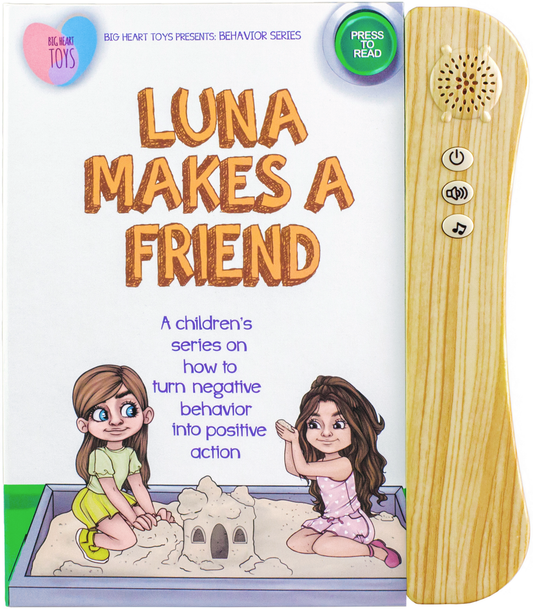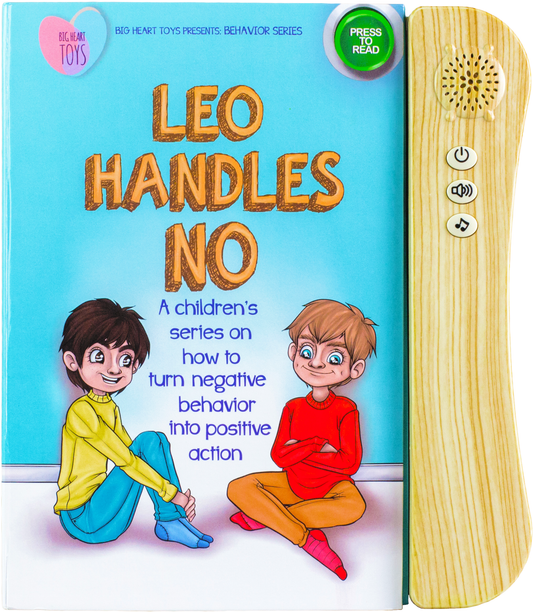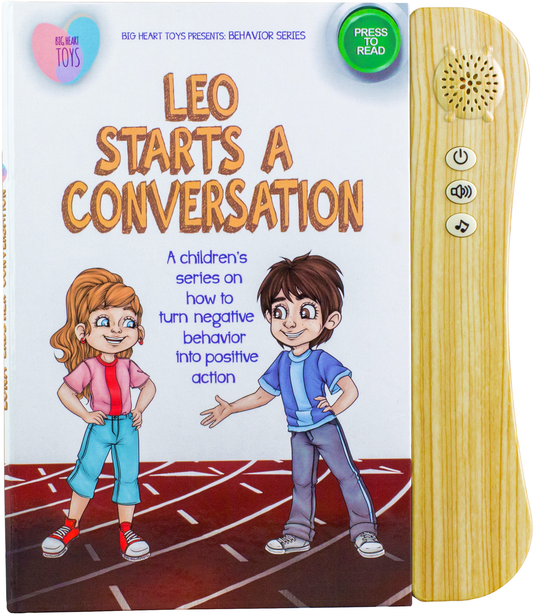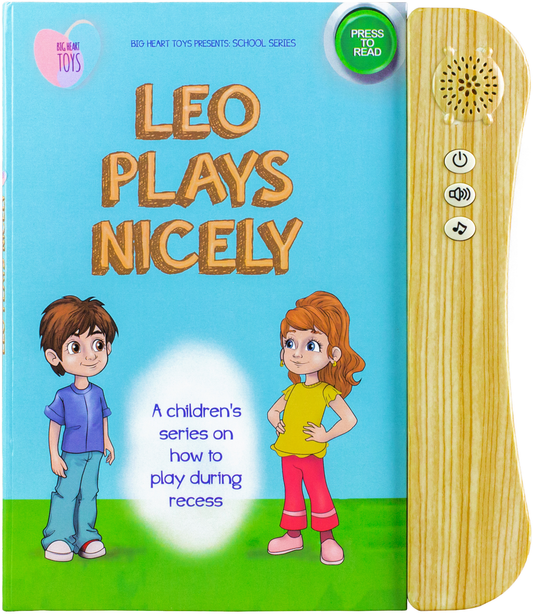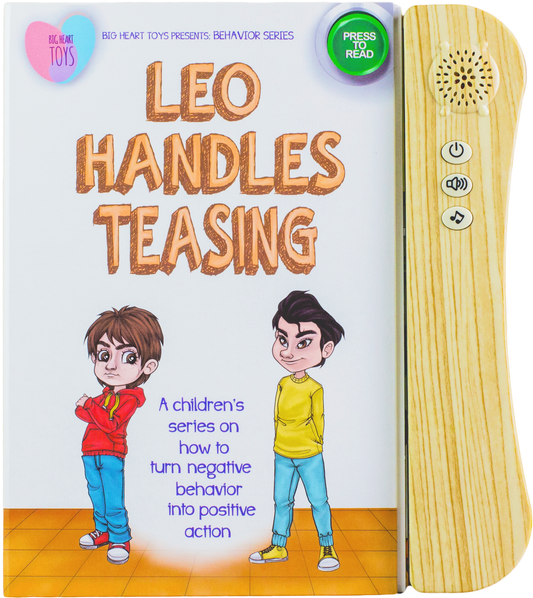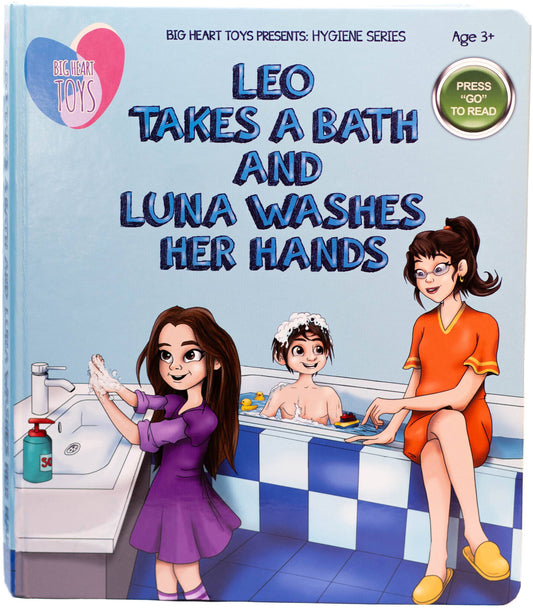
Interactive Books
Growing essential life skills relies on two key pillars: emotional regulation and behavior modeling.
By building emotional regulation skills, we empower children to navigate through challenging situations, resolve conflicts, and build meaningful connections.
Through positive behavior modeling, we guide them in developing vital social skills, fostering empathy, nurturing self-control, and embracing effective strategies for conflict resolution.
What sets these interactive children's books apart is their thoughtful design, featuring audio playback buttons that bring the pages to life through captivating narration. Explore our book options and their themes below to select the best interactive books for your child's development.
-
Leo Deals With Anger
Regular price $18.95Regular priceUnit price per -
Luna Makes A Friend
Regular price $18.95Regular priceUnit price per -
Leo Handles No
Regular price $18.95Regular priceUnit price per -
Leo Starts a Conversation
Regular price $18.95Regular priceUnit price per -
Leo Plays Nicely
Regular price $18.95Regular priceUnit price per -
Leo Uses Manners
Regular price $18.95Regular priceUnit price per -
Leo Survives The Fire Drill
Regular price $18.95Regular priceUnit price per -
Leo Handles Teasing
Regular price $18.95Regular priceUnit price per -
Luna Ends Her Conversation
Regular price $18.95Regular priceUnit price per -
Luna Pulls Hair
Regular price $18.95Regular priceUnit price per -
Leo Takes a Bath and Luna Washes Her Hands
Regular price $25.00Regular priceUnit price per
Collapsible content
What Makes a Children's Book Interactive?
A children's book becomes interactive when it incorporates multimedia elements like touch, sound, and visuals, encouraging active engagement and participation. Interactive features can occur in a multitude of ways that go beyond the traditional printed pages of a book. Interactive books might include animations, puzzles, games, read-aloud features, and more to engage little readers and enhance their reading experience.
Pop-Up Illustrations and Flaps
Three-dimensional visuals bring stories to life and create an element of surprise. Certain portions of the pictures or text hiding behind flaps will pique your child’s curiosity, and they get to discover the mystery behind the pop-up or flap. The increased intrigue creates a multisensory learning experience, incorporating tactile and visual cues that add appeal to a story. Your child won’t be able to wait for the next page!
Pull Tabs and Moveable Parts
Books with movable parts and tabs encourage your child’s interaction through manipulation and movement while also engaging fine motor skill development. Similarly to pop-ups and flap books, these tabs reveal hidden images that create an element of surprise. Characters in the story can move or change scenes to accompany the book’s storytelling elements and create a more engaging reading experience.
Touch-and-Feel Books
The ever-popular touch-and-feel feature is commonly used in board books for toddlers and little ones. These books create a stimulating sensory exploration using many different textures and materials. This engages children in a tactile sensory experience and encourages fine motor development.
Stickers and Activities
Some children’s books tell the story in a typical manner but include stickers or activities at the end for children to add to the story as they read. This style of book promotes creativity when reading and hands-on engagement, assisting in the development of fine motor skills. Little ones are encouraged to make the story their own and personalize it as they interact with their reading.
Interactive Storytelling Techniques
When reading a book to or with a child, incorporate prompts, cues, or questions to encourage their active participation. Active storytelling like this will help support comprehension skills and language and communication development. In doing so, you open the door for dialogue and provide decision-making opportunities.
What Are the Different Types of Interactive Books?
Interactive books are any books that go beyond the traditional pages of a book and add an engaging element to the story. Let’s dive into the most popular types of interactive books so you’re prepared next time you’re looking for a new bedtime story.
Picture Books With Interactive Elements
Interactive picture books integrate features that stimulate imagination and storytelling skills within visually engaging narratives. Various interactive features, such as lift-the-flaps, pop-ups, touch-and-feel textures, sound buttons, sliders, and more, may appear. The elements are strategically integrated into the illustrations, encouraging young readers to actively participate in the story.
Board Books for Toddlers and Preschoolers
As mentioned, board books are often geared toward toddlers and preschool-aged children. These books have sturdy pages that are easy for little hands to flip and manipulate without damage and incorporate interactive components suitable for these early readers. These books typically have very direct, minimal text introducing littles to basic concepts and early literacy skills.
Rhyming and Interactive Storybooks
Rhythmic patterns and interactive elements enhance language development and phonemic awareness. Rhyming not only enhances language development but provides a sense of predictability so children can use their knowledge of rhyming words to guess what might come next. Using rhyme brings a lyrical nature to stories that sparks creativity and imagination.
Interactive Books for Babies and Little Ones
Books specifically designed for babies and young children are typically designed with age-appropriate interactive features for sensory exploration. They are made to promote early cognitive and motor development and foster an early love of reading and learning.
Why Are Interactive Books Beneficial for Toddlers and Young Children?
Interactive books are beneficial because they engage multiple senses, promoting cognitive development, language skills, and early literacy. The interactive elements foster curiosity, imagination, and fine motor skills while creating positive associations with reading, making the learning experience impactful for young minds. These books cater to the developmental needs of toddlers and young children, providing an enriching and enjoyable way to introduce them to the world of literature.
Fostering Language Development and Vocabulary
Interactive books encourage verbal expression and conversation, expanding vocabulary through dialogue and prompts. The unique features of an interactive book allow children to express their opinions, customizing their reading experience. Rather than just listening to a story, they are joining as another storyteller to practice their language and communication development.
Stimulating Cognitive Skills and Imagination
Interactive books encourage problem-solving, critical thinking, and creativity, all of which enhance cognitive abilities. They spark children’s imagination and facilitate imaginative play. Children can begin to solve problems or brainstorm different outcomes for a story they’re reading.
Developing Fine Motor Skills and Hand-Eye Coordination
Most of the interactive features of these books allow children to manipulate moving parts and incorporate tactile elements that support motor development. These books provide intentional activities that enhance hand-eye coordination and dexterity in a fun, entertaining way.
Promoting Literacy and Love for Reading
Engaging with a book's storytelling and interactive elements fosters a positive reading experience and creates a bonding time that instills a love of books. These intentional positive experiences can create lifelong learners and readers and make reading seem more pleasurable than task-based.
Encouraging Interactive Storytelling and Imagination
Interactive books invite children to become active participants in the story rather than just listeners. While on the receiving end of a story, they get the opportunity to engage in creative thinking, role-playing, and storytelling scenarios, enhancing the whole experience.
Supporting Early Learning Concepts (Colors, Shapes, Numbers, etc.)
Many interactive books introduce and reinforce foundational concepts. Children learn basic foundational skills without even realizing they are being taught something. This, in turn, enhances early literacy, numeracy, and cognitive development.
Facilitating Parent-Child Bonding and Interactive Storytime
These types of books create opportunities for shared experiences and bonding between parents of loved ones and their children. This valuable quality time encourages meaningful interactions and conversations and creates memories that can last a lifetime. Your child will love reading because they first learned to love it with you.
Interactive Children's Books Recommendations and Book List
To save you the research, we have consolidated a list of some of the best interactive books for little ones. These beloved books feature a variety of interactive elements, making them wonderful additions to your little one’s bookshelf.
- "Dear Zoo" by Rod Campbell
- "Mix It Up!" by Hervé Tullet
- "Don't Push the Button!" by Bill Cotter
- "Tap the Magic Tree" by Christie Matheson
- "Can You Make a Scary Face?" by Jan Thomas
- "Wiggle" by Doreen Cronin
- "Chomp" by Matthew Van Fleet
- "Larry Gets Lost in Fairy Tale" by John Skewes and Michael Mullin
- "Tickle" by Leslie Patricelli
- "Press Here" by Hervé Tullet
- "The Very Hungry Caterpillar" by Eric Carle
The Bottom Line
Interactive children's books offer numerous benefits, such as engaging young readers with interactive elements, promoting multisensory learning for better comprehension, fostering imagination and creativity, and encouraging active participation and problem-solving skills. Through interactive reading, you can foster a love of reading and provide a fun, immersive educational experience for your child’s cognitive and emotional growth.
Interactive books promote inclusivity by accommodating different learning needs and making reading accessible to all children. Utilizing these fun books helps children build on language and communication skills and provides a multitude of ways for children to engage in reading even when they can’t yet read on their own.
Check out a variety of interactive books that teach children valuable life lessons and social skills from the Big Heart Toys collection.
Sources:
Multisensory Experiences | A Primer | Frontiers
Fine Motor Development Chart | Kid Sense
All About Language Comprehension: What it is and How it can Help your Child Read | NWEA


